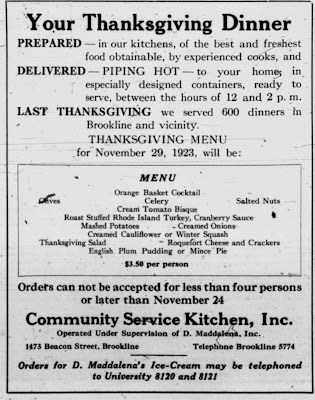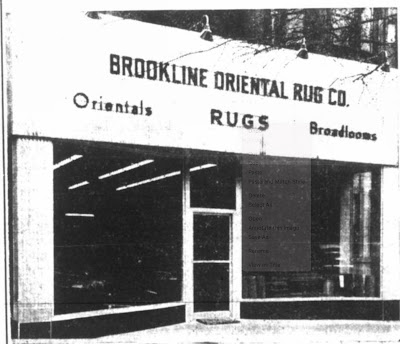 |
| An early advertisement for what is now the VCA Brookline Animal Hospital |
You might say 2023 went to the dogs in Brookline. And the cats and the gerbils and the guinea pigs and …. you name it.
Two new (to Brookline) veterinary clinics – Boston Veterinary and Small Door – opened branches in former retail spaces in Coolidge Corner; one at the corner of Beacon and Pleasant Streets and the other on Harvard Street next to Otto Pizza.
But also on the move in 2023 was a veterinary clinic that's hardly a newcomer to town. It's the Brookline Animal Hospital, which began on Boylston Street in 1909, in the building that's now the restaurant La Morra.
 |
| 46-48 Boylston Street in the 1980s. Vacant at the time the picture was taken, it had most recently been a restaurant called Open Sesame. The building has been La Morra since 2003 |
Brookline Animal Hospital's Beginnings
 |
This ad announcing the new animal hospital appeared in the Brookline Chronicle on Christmas Day, 1909. The second address shown, 8 Boylston Street, was in a nearby stable where the vets apparently saw patients.
|
Articles in the Brookline Press and the Brookline Chronicle from the year the hospital opened provide a detailed description. The hospital, wrote the Press, "is not only a model of neatness, but one of the most commodious and finely equipped in this region."
"There are in the hospital private rooms for cats and dogs, and one large and roomy ward where there are five ways of caring for these animals."
In addition, continued the article,
"proper provisions have been made for all surgical operations and treatment of horses and cattle where conditions at the owners' premises are unfavorable. . . The runs, indoor and outdoor, for the exercise of animals are most complete."
The veterinarians running the hospital were Edward T. Ryan and Jesse F. Humphreville, both graduates of the veterinary school at the University of Pennsylvania. Humphreville left to open his own practice in Waltham in 1916 or 1917, but Ryan -- and later his son Edward Jr. -- ran what was then called the Brookline Hospital for Animals for 65 years, until the younger Ryan's death in 1974.
 |
| Edward T. Ryan, Sr. (1882-1946) and Edward T. Ryan, Jr. (1916-1974) in their yearbook photos from the University of Pennsylvania School of Veterinary Medicine |
In 1913, the elder Ryan moved his hospital to a new commercial building, known as Chase's Block, at the corner of lower Washington Street and Pearl Street. He would remain there for eight years.
 |
| Chase's Block under construction in 1912. The building was torn down in 2015 and replaced by a new multistory office building. It had been home in more recent years to such restaurants as Bertucci's, Skipjack's, and New England Soup Kitchen. |
The Move to Winchester and Coolidge Streets
In 1919, Ryan and his wife, Julia, bought the house at 143 Winchester Street, at the corner of Coolidge Street, and an adjacent Coolidge Street carriage barn. In 1921 they moved the veterinary practice into the former carriage barn next to their new home.
 |
| 143 Winchester Street today |
 |
| Brookline Chronicle, October 1, 1921 |
During World War II, the older Ryan served as a supply officer stationed at Fort Devens and elsewhere. He became ill during that time and died in 1946. His son, Edward, earned his own degree in veterinary medicine in 1943 and took over the practice.
Edward Ryan, Jr., who was 27 when he got his veterinary license and succeeded his father, continued to run the hospital until his death in 1974. He no longer lived in Brookline after his marriage in 1948, though his mother, Julia, continued to live in the house next to the hospital. A hospital employee lived there after her death in 1954.
Trouble with Neighbors
Ryan had trouble with the neighbors in the 1960s, facing complaints about "barking and vicious disposition of the dogs." (The local newspaper found the whole kerfuffle amusing, with headlines like "Barks bite neighbors" and stories about neighbors' complaints being "muzzled" when not enough of them showed up at a hearing.)
 |
| This article about a hearing on the Brookline Hospital for Animals appeared in the Boston Globe in 1966. |
In 1976, Dr. Rodney Poling, a veterinarian who had come to Boston for an internship at Angel Memorial Hospital, bought the practice from Edward Ryan, Jr.'s widow. Poling, who grew up on a cattle and hog farm in Ohio, received his Doctor of Veterinary Medicine degree from Ohio State University in 1973.
I spoke with Poling, now a vet in Texas. The hospital, he told me, had equipment in it from the Ryans' long tenure on the site, even including a horse stall and a cow stanchion in the basement. (A cow farm on Corey Hill had, at one time, been the Ryans' biggest customer, he said.)
 |
| 1980 advertisement for the Brookline Animal Hospital |
Four years after taking ownership of the hospital, Poling decided to move his growing practice, which he had renamed the Brookline Animal Hospital, to Boylston Street. His plans drew support from some neighbors but vehement opposition from others. Poling modified the plans and, in July 1981, bought the proposed site -- 370-376 Boylston, on the south side of the street -- for $200,000.
Further debate, downsizing of the original plans, and additional modifications continued for two years before Poling gave up and decided to move his practice elsewhere. "It was their contention that it would be a dirty, stinking place," Poling told the Brookline Chronicle Citizen. "I don't think they gave us a fair chance."
Ironically, the location the hospital moved to in 2023 is directly across Boylston Street from the location that Poling was prevented from moving to in the 1980s. (The building on Coolidge Street that had been the hospital was torn down and replaced by a new house. The adjacent house on Winchester Street, now a two-family home, remains.)
The Move to Brookline Avenue
In 1983, Poling purchased the former Back Bay Welding Co. building on Brookline Avenue, near the intersection with lower Washington Street. In March 1984, the hospital moved to its new quarters, where it would remain for 39 years.
 |
| The Brookline Animal Hospital in the building that was its home from 1984 to 2023. |
"No more lunches on the x-ray table," reported the Chronicle Citizen, "no clambering through the darkroom to get to the bathroom, and hopefully fewer three-ring circuses in the now larger waiting room."
 |
| Dr. Rodney Poling in a 1986 ad for the hospital in the Brookline TAB. "Our goal is to show concern for both the animals and their owners," said Poling in the ad, "to use state of the art technology, without some of the impersonal style which sometimes accompanies it." |
Poling sold the Brookline practice in the early 2000s and went on to open other veterinary practices in Massachusetts before moving, in 2021, to Texas, where he leads the Prairie Creek Animal Hospital in East Austin.
The Brookline Animal Hospital has been part of the VCA Animal Hospital network since 2007. (VCA also operates the Metro Cat Hospital in Washington Square.)
Dr. Scott Groper, who started working under Poling in 1995 after earning his veterinary degree from the Tufts University School of Veterinary Medicine, is now the Brookline Animal Hospital's medical director.
That's one more bit of continuity to a Brookline institution that has been taking care of local animals for more than a century.



























